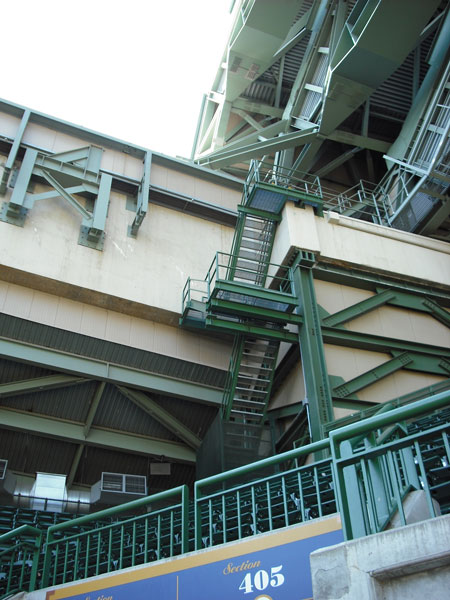
Our route up to the roof as viewed from the nosebleed seats
Click here to go to the Baseball Bum webpage. Click here to see some of the other things that I like to do.
After tramping around Arizona as a baseball bum for a few years, opportunities opened up in Wisconsin. I got a gig as a tour guide at Miller Park. I'm a Milwaukee Brewers employee now. Naturally, I want to run in the Sausage Race and ride on Bernie Brewer's slide. Also, I wanted to see the roof up close. As the 2010 season was winding down my boss rounded up the tour department for a roof tour.

Our route up to the roof as viewed from the nosebleed seats
The tour started in the corporate offices, where we saw a presentation on the structure of Miller Park with special detail on the roof. The roof is over 12,000 tons of structural steel, and it features a unique "clamshell" layout that pivots behind home plate and swings open to stack up over the first base and third base grandstands. There are five moving sections, and each section is powered by two sixty horse power electric motors. We took the elevator up to the 4th deck of the right field grandstands and then climbed a maintenance staircase up to the stack of roof panels over the grandstands along the 1st base/right field side of the park.
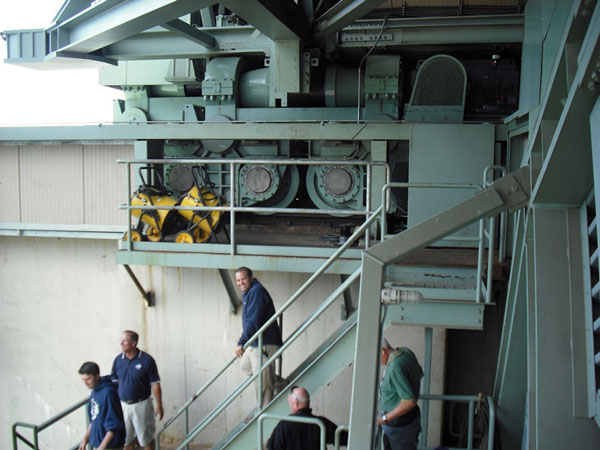
Access to the roof, showing one of the Bogie Wheel assemblies
Our first stop was an inspection of a bogie assembly. There are two bogie assemblies on each of the five moving roof panels. If I'm doing the math correctly, that's a total of ten bogies for those of you keeping score. Each bogie is powered by a 60-hp motor, which is chain driven to a drive wheel that rides on a rail. The rail curves around the outfield, and looks a lot like a wider version of a single rail from a train track.
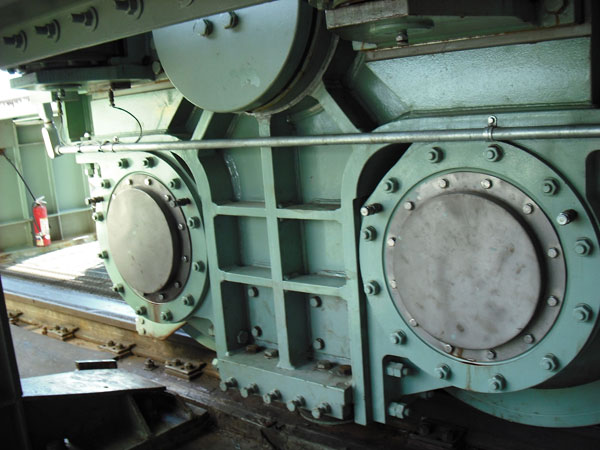
Close Up Detail of the Bogey Wheels
Each roof panel is triangluar, six hundred feet long and about one hunderd feet wide at the outfield end. Behind home plate, the panels come to an apex and ride on a pivot. The panels weigh around 2,000 tons, so it's a good approximation to say that each pair of bogy assemblies carry about 1,000 tons. It would be a mistake to bolt the outfield corners of the roof directly to the bogies, because the roof expands and contracts up to two feet during changes in temperature. If there is no way to allow the roof to expand, in other words if the roof was rigidly bolted to the bogies, the bogey wheels would not ride on the roof rails easily-the wheels would pe pushed off the outfield side of the track when the steel expanded during the heat of summer. The expansion rollers pictured below allow the roof to slide back and forth during thermal expansion & contraction.
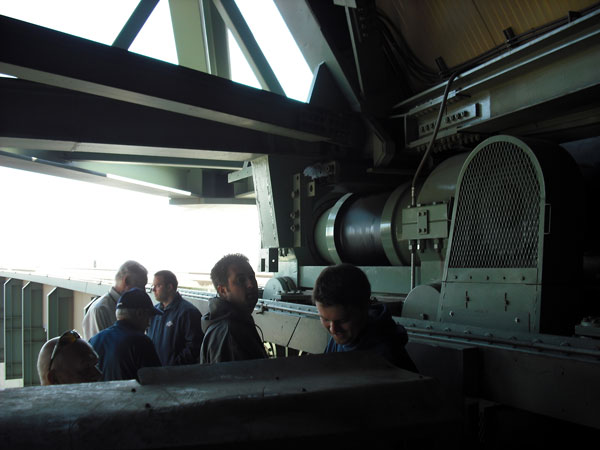
These Rollers Allow the Roof to Expand 18" in Hot/Cold Temperatures
Next, we crawled under the ourboard edge of the roof, next to the bogie assembly, and took in the view of west Milwaukee from the right field side of the roof. It was a nice sunny day with a cool breeze coming off Lake Michigan. Sometimes I really like being involved in baseball, and this was one of those times.

Outside the Ballpark, Way Up High
Finally we were ready to hike over the right field/1st base catwalk. For those with acrophobia, the fear of heights, this is a very stressful part of the tour. We've had guys go to their hands and knees, crawling over the catwalks, but more often the guys just clamp their hands to the handrails and pull themselves along. It can be a real "white knuckle" experience, and the old cliche "don't look down" applies. The catwalks (there are two, one down the 1st base line and one down the 3rd base line) follow the curvature of the roof. They start off low at the outfield ends, then curve up to a point about three hunderd feet above the playing surface, then arc back down to a point behind home plate where the pivots are.
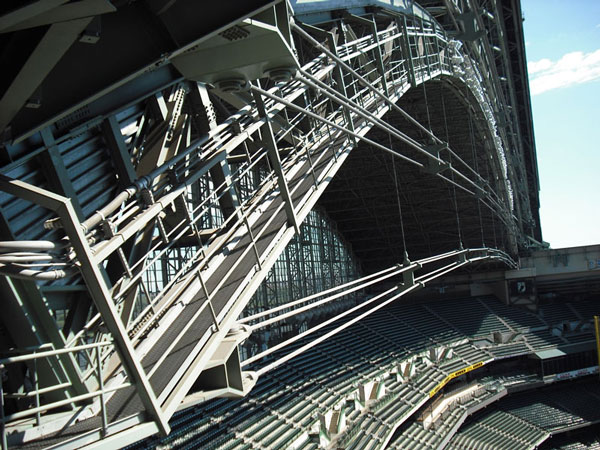
The Catwalk Along the First Base Line, Showing the Cables that Maintain the Curve of the Panel
Here we're almost at the top of the arc, three hundred feet up. The big stadium lights are bolted to the catwalk, and changing the bulbs must be a real highwire act.
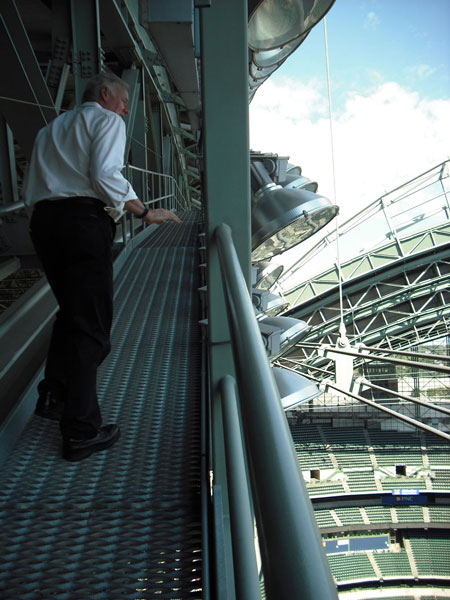
Up Near the Top of the Catwalk
This shot was taken from behind home plate, near the roof pivots. The shot shows the left field roof stack, the outfield ballpark structure that supports the bogie wheel track and the skyline of Milwaukee in the distance. After we took in the view we retraced our path back across the catwalk.
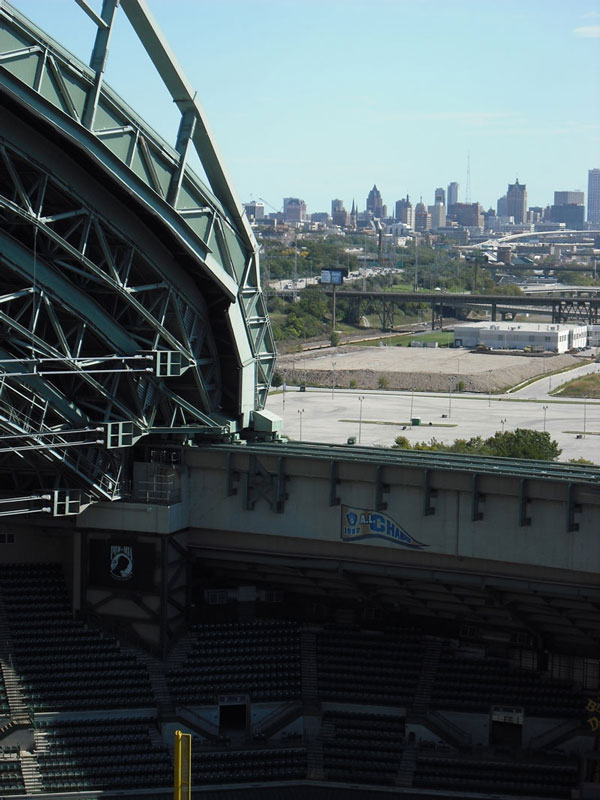
The City Skyline, Viewed from Above Home Plate
Now, when we got back we checked everybody's hands to see how brave each of us were. People who don't like heights tend to hold on to the handrails for dear life, so their hands get dirtier than folks who are comfortable 300' in the air. The cleaning crews don't go up on the catwalks, so the handrails stay dirty. You can tell by the hands who was okay with the heights and who was tense.
One Barrel rum webpage My dogs
Click here to e-mail me.